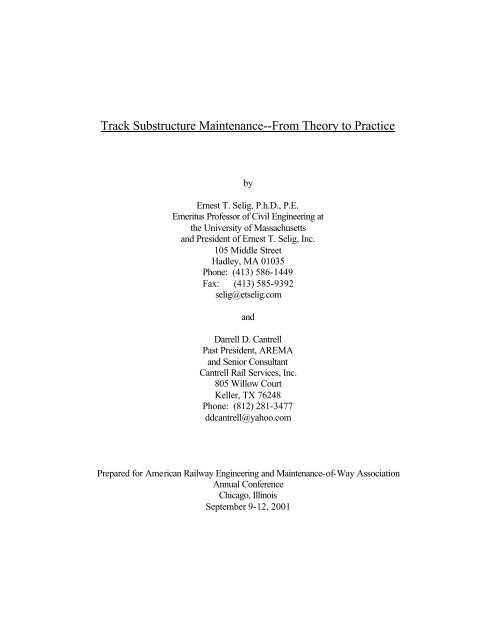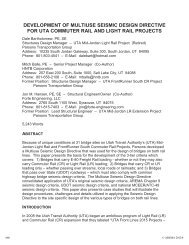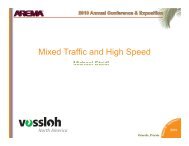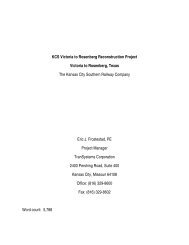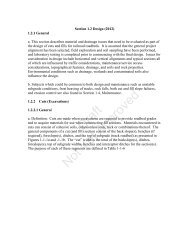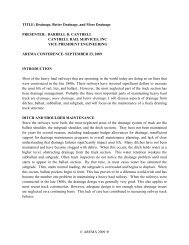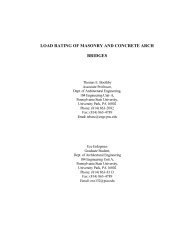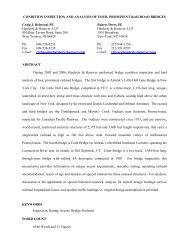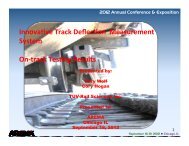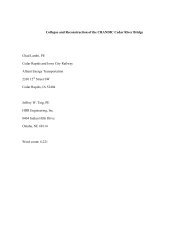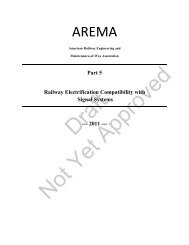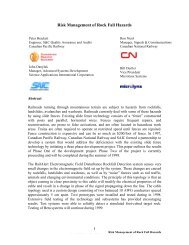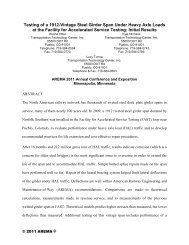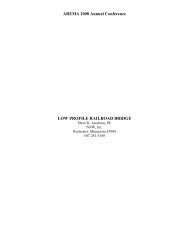Track Substructure Maintenance--From Theory to Practice - AREMA
Track Substructure Maintenance--From Theory to Practice - AREMA
Track Substructure Maintenance--From Theory to Practice - AREMA
You also want an ePaper? Increase the reach of your titles
YUMPU automatically turns print PDFs into web optimized ePapers that Google loves.
<strong>Track</strong> <strong>Substructure</strong> <strong>Maintenance</strong>--<strong>From</strong> <strong>Theory</strong> <strong>to</strong> <strong>Practice</strong><br />
by<br />
Ernest T. Selig, P.h.D., P.E.<br />
Emeritus Professor of Civil Engineering at<br />
the University of Massachusetts<br />
and President of Ernest T. Selig, Inc.<br />
105 Middle Street<br />
Hadley, MA 01035<br />
Phone: (413) 586-1449<br />
Fax: (413) 585-9392<br />
selig@etselig.com<br />
and<br />
Darrell D. Cantrell<br />
Past President, <strong>AREMA</strong><br />
and Senior Consultant<br />
Cantrell Rail Services, Inc.<br />
805 Willow Court<br />
Keller, TX 76248<br />
Phone: (812) 281-3477<br />
ddcantrell@yahoo.com<br />
Prepared for American Railway Engineering and <strong>Maintenance</strong>-of-Way Association<br />
Annual Conference<br />
Chicago, Illinois<br />
September 9-12, 2001
<strong>Track</strong> <strong>Substructure</strong> <strong>Maintenance</strong>--<strong>From</strong> <strong>Theory</strong> <strong>to</strong> <strong>Practice</strong><br />
by<br />
Ernest T. Selig, P.h.D., P.E. and Darrell D. Cantrell<br />
Abstract<br />
The three main components of track substructure are ballast, subballast and subgrade.<br />
Their functions and how they are achieved will be reviewed. All three components must be<br />
present and functioning satisfac<strong>to</strong>rily for good track performance. <strong>Substructure</strong> maintenance is<br />
mainly concentrated on the ballast and the need is usually dictated by track geometry<br />
deterioration. Second in priority for substructure maintenance are drainage ditches. The<br />
principles of drainage will be summarized. In practice drainage is often given inadequate<br />
attention. The cost of maintenance or, conversely, the deterioration of track components, is<br />
directly impacted by the condition of the drainage system. Information on these cost fac<strong>to</strong>rs will<br />
be presented. When normal maintenance operations cannot provide satisfac<strong>to</strong>ry track<br />
performance, reconstruction will be needed. This usually involves work on the subballast,<br />
subgrade or drainage system <strong>to</strong> repair the defects. Subgrade treatment methods are described.<br />
These are more expensive, and more difficult <strong>to</strong> accomplish tasks, and more disruptive <strong>to</strong><br />
revenue traffic. Thus a goal of maintenance planning should be <strong>to</strong> minimize the need for the<br />
reconstruction by not allowing chronic problems <strong>to</strong> develop or persist, <strong>to</strong> the extent possible.<br />
Guidelines for maintenance practice will be presented. The paper also emphasizes the<br />
importance of determining the cause of the maintenance problems in order <strong>to</strong> apply the proper<br />
solutions. A follow up investigation is recommended <strong>to</strong> evaluate the results. Finally education<br />
programs are recommended <strong>to</strong> provide a much needed understanding of the fundamentals of<br />
track substructure behavior.
INTRODUCTION<br />
The substructure consists of ballast, subballast, and subgrade. The need for substructure<br />
maintenance stems from the development of excessive geometry deviations (track<br />
roughness). <strong>Track</strong> geometry loss results from movements in the ballast, subballast, and<br />
subgrade. However, adjustment of geometry is done by rearranging the ballast. There<br />
are various causes of geometry loss which need <strong>to</strong> be identified <strong>to</strong> know how <strong>to</strong> improve<br />
track performance. The amount of maintenance required is influenced by decisions made<br />
during design and construction or rehabilitation of the track. The railroad may choose <strong>to</strong><br />
correct the geometry faults by tamping as needed. This should only be done where<br />
needed, but tamping is often extended <strong>to</strong> adjacent areas that do not need adjusting.<br />
Tamping is appropriate, but it does damage the ballast and may not be economical in<br />
frequently reoccurring problem spots. Further, tamping does not correct the root cause of<br />
the roughness. Thus the need <strong>to</strong> find the cause and fix the problem arises (1).<br />
If the tamping improvement does not last long enough, then the ballast condition<br />
should be checked. If the fouling is excessive then undercutting with the addition of new<br />
ballast as needed will be programmed, or alternatively the track will be raised so that<br />
additional ballast can be placed under the ties. If excessive fouling is not the problem or<br />
if the undercutting process does not improve the performance, then an examination is<br />
required <strong>to</strong> determine the cause of the reoccurring geometry problem.<br />
The drainage of railway track is recognized as a fundamental, yet often neglected<br />
aspect of track design. <strong>Track</strong> drainage significantly affects track performance and track<br />
maintenance requirements. A complete drainage system must include means of handling
water flowing over the ground surface <strong>to</strong>wards the track, shedding or draining water<br />
falling on<strong>to</strong> the track, and controlling water from the subgrade (2).<br />
SUBSTRUCTURE COMPONENTS<br />
The ballast is the <strong>to</strong>p structural layer that, among other things, holds the track in place,<br />
reduces the stress transmitted <strong>to</strong> the subgrade, and facilitates the geometry adjustment<br />
through tamping (3,4). Fouling is the main cause of ballast problems. Once the cause of<br />
the fouling is determined the solutions can easily be identified and applied.<br />
The best choice of ballast for a particular location is the most cost-effective<br />
choice, taking in<strong>to</strong> consideration traffic, environmental conditions, and cost of material<br />
delivered <strong>to</strong> the site. The best choice, therefore, will not necessarily be the highest<br />
quality material or the material that has the lowest delivered cost. These costs include<br />
purchase and transportation of ballast as well as tamping and undercutting/cleaning.<br />
The subballast is the second structural layer that helps the ballast reduce the stress<br />
<strong>to</strong> subgrade, maintains separation between the ballast and subgrade particles, and plays an<br />
important role in track drainage (1). Subballast deserves more attention than it gets<br />
because of its importance <strong>to</strong> track performance. Filter fabric (geotextile) has frequently<br />
been used <strong>to</strong> fulfill some of these subballast functions, but investigations have shown that<br />
fabric is not generally desirable (1). Asphalt concrete is an alternative or supplement <strong>to</strong><br />
sand/gravel subballast materials, but the economics will probably limit asphalt <strong>to</strong> special<br />
cases.<br />
Subgrade serves as the platform for the structural layers, and so it must be stable.<br />
The subgrade has many modes of failure such as: attrition, squeeze, progressive
compression under repeated loading, consolidation, massive shear, frost heave/thaw<br />
softening and swelling and shrinking from moisture change (1). Investigation is needed <strong>to</strong><br />
know which is the cause of the subgrade problem in a specific case in order <strong>to</strong> choose the<br />
correct cure. This determination may be easy, but often it can be very challenging.<br />
Subgrade problems are clearly more difficult <strong>to</strong> correct, than ballast or subballast<br />
problems, especially after the track has been constructed. But there are a lot of possible<br />
solutions <strong>to</strong> subgrade problems.<br />
BALLAST FOULING<br />
Over a period of time in track the ballast gradation typically becomes broader and finer<br />
than the initial condition because the larger ballast particles will break in<strong>to</strong> smaller<br />
particles and additional smaller particles from a variety of sources will infiltrate the voids<br />
between the ballast particles. This process is known as fouling. Fouling deteriorates<br />
ballast performance and eventually requires undercutting/cleaning or track raising with<br />
ballast replacement when tamping improvements do not last long enough<br />
Five categories of fouling material have been identified: 1) particles entering from<br />
the surface such as wind blown sand or coal falling out of cars; 2) products of wood or<br />
concrete tie wear; 3) breakage and abrasion of the ballast particles; 4) particles migrating<br />
upward from the granular layer underlying the ballast; and 5) migration of particles from<br />
the subgrade (1). The main causes of ballast fouling must be identified if proper steps are<br />
<strong>to</strong> be taken <strong>to</strong> reduce the rate of fouling. The most frequent cause of ballast fouling is<br />
ballast breakdown, but there are individual situations in which each one of the other<br />
categories predominates.
Geotextiles (filter fabrics) generally have not been found <strong>to</strong> be useful in solving<br />
ballast fouling problems. A proper subballast layer is the best cure for fouling from the<br />
underlying granular layer and from the subgrade. When subgrade is the source of fouling<br />
material one of two main mechanisms usually is present: 1) abrasion of the subgrade<br />
surface by ballast particles in contact with the subgrade, or 2) hydraulic erosion of water-<br />
filled cracks in the subgrade subjected <strong>to</strong> repeated train loading.<br />
BALLAST/SUBBALLAST LAYER THICKNESS<br />
The thickness of the ballast layer beneath the ties generally should be the minimum that<br />
is required for the ballast <strong>to</strong> perform its intended functions. Typically this will be 12 <strong>to</strong><br />
18 in.. The minimum subballast layer thickness beneath the ballast should be 6 in. Thus,<br />
the minimum granular layer thickness beneath the ties would be 18 <strong>to</strong> 24 in. A check<br />
then needs <strong>to</strong> made <strong>to</strong> determine whether this is enough thickness <strong>to</strong> prevent<br />
overstressing the subgrade (5,6). An overstressed subgrade will result in rapid loss of<br />
geometry under train traffic.<br />
BALLAST CLEANING AND RENEWAL<br />
Ballast cleaning and renewal is an expensive and time-consuming process which is also<br />
highly disruptive <strong>to</strong> train traffic. Thus, the need for this process must be considered<br />
carefully. Basically ballast cleaning and renewal is required when the ballast becomes so<br />
fouled that it cannot fulfill its functions.<br />
Care must be taken during ballast cleaning <strong>to</strong> prevent removing or damaging the<br />
existing subballast layer. Care must also be taken <strong>to</strong> ensure that the width and inclination<br />
of the cut surface are such that the water collecting in the cleaned ballast is able <strong>to</strong> flow
freely across the cut surface and in<strong>to</strong> the track side drainage system. Effort made <strong>to</strong><br />
achieve a geometrically smooth cut surface will also improve the stability of the track<br />
geometry under subsequent traffic after the cleaning and renewal process is completed.<br />
The economic benefit of ballast cleaning and renewal will not occur unless the<br />
drainage system is functioning as well (7). Thus, a ballast cleaning and renewal program<br />
should also accommodate installing or repairing the drainage system. It is also desirable<br />
<strong>to</strong> evaluate the cause of the ballast fouling and consider taking steps <strong>to</strong> correct the cause<br />
of the fouling in order <strong>to</strong> reduce the amount of future undercutting.<br />
Shoulder cleaning can lengthen the time before undercutting cleaning is required<br />
(7). The shoulder cleaning must include the full depth of the shoulder all the way out <strong>to</strong><br />
the ballast <strong>to</strong>e. Shoulder cleaning improves drainage by shortening the drainage path of<br />
water out from under the ties and increases the depth of drainage below that which is<br />
typically achieved with undercutting/cleaning. Partial depth undercutting will not result<br />
in effective drainage of water from the uncleaned lower portion of the ballast layer.<br />
Shoulder cleaning also allows migration of fouling materials out from under the<br />
track in<strong>to</strong> the clean voids in the shoulder in order for the fouling material <strong>to</strong> migrate, the<br />
fouling particles must be much smaller than the voids in the ballast and need a forcing<br />
mechanism such as flowing water or pumping by repeated train loading. When the<br />
fouling material results from breakdown of the ballast in a way that produces a broad<br />
range of particle sizes, migration of the fouling material is not likely <strong>to</strong> be significant.<br />
SUBGRADE TREATMENT METHODS<br />
The following are a few examples of subgrade remedial treatment methods:
1. Grouting--Some grouts penetrate the voids of the soils (permeation grouting) and<br />
strengthen them or reduce water seepage. Other grouts compact and reinforce the<br />
soils (compaction grouting) <strong>to</strong> strengthen them or displace the soils <strong>to</strong> compensate for<br />
settlement. Jet grouting mixes cement with soil <strong>to</strong> form columns of strengthened soil.<br />
2. Soil mixing--A process in which soil is mixed with augers and paddles <strong>to</strong> create a<br />
mixture of soil and cement based grout. Soil mixing creates a column of strengthened<br />
soil for compression and shear reinforcement.<br />
3. Lime modification of clay properties--Lime can be used <strong>to</strong> improve the properties of<br />
clay. Techniques for mixing lime with clay include mechanical mixing (admixture<br />
stabilization) and quicklime piles. Injecting lime in<strong>to</strong> clay in slurry form has been<br />
performed with the expectation of improving the clay properties. This is a common<br />
but not usually effective treatment with often undesirable side effects, e.g. slurry<br />
injection can fracture clay instead of penetrating the voids and also solidifies ballast<br />
(8).<br />
4. Reconstruction--Compaction of existing soils or replacing them with better soils will<br />
give improved subgrade. Chemicals can also be mechanically mixed with the soils in<br />
layers which are then recompacted <strong>to</strong> form a stronger or less reactive soil. The<br />
chemistry of the soils should be checked or tests performed <strong>to</strong> verify the effectiveness<br />
of the treatment, because some combinations can be harmful.<br />
5. Reinforcement--Various plastic grids, metal strips or cellular materials placed in the<br />
soils give tensile reinforcement. Alternatively, steel reinforcing can be installed in<br />
the subgrade soils through techniques such as soil nailing, soil doweling and<br />
micropiling.
6. Stress reduction--Increasing the thickness of the ballast and subballast will reduce the<br />
pressure on the weaker subgrade caused by the train loading. Contrary <strong>to</strong> the<br />
<strong>AREMA</strong> engineering manual, the allowable pressure is not constant, but varies<br />
widely and must be determined in each case for correct design. The correct strength<br />
considers the magnitude of the repeated loading from the trains and the number of<br />
repetitions. For a given axle load, a high <strong>to</strong>nnage line would have a much lower<br />
apparent strength than a low <strong>to</strong>nnage line. Thus the high <strong>to</strong>nnage line needs a greater<br />
ballast/subballast thickness for the same subgrade properties (5,6).<br />
IMPORTANCE OF PROPER INVESTIGATION<br />
A fundamental limitation of common railroad practice regarding substructure remedial<br />
work is the lack of a proper investigation <strong>to</strong> diagnose the cause of the problem before<br />
attempting a solution. A proper investigation includes using trained personnel who<br />
understand the fundamentals of what is being observed and recognize appropriate<br />
solutions.<br />
This limitation of inadequate investigation is compounded by not following up <strong>to</strong><br />
evaluate the results of the remedial work. Thus, sometimes improvements occur but for<br />
reasons other than the ones expected. Other times improvements do not occur, and<br />
sometimes the problem gets worse. In these cases the reasons will not be known without<br />
a follow up investigation. One consequence of inadequate follow up is that the decision<br />
about whether or not <strong>to</strong> use the same method elsewhere cannot be reliably made.<br />
The inevitable result of investigation deficiencies is inefficient use of maintenance<br />
resources or a poor return on the investment. An example is that mud in the ballast is
commonly thought <strong>to</strong> derive from subgrade soil particles. This has led <strong>to</strong> the<br />
inappropriate use of filter fabric. Investigations have shown that subgrade is rarely the<br />
source of the mud and even in cases where it was, the fabric did not s<strong>to</strong>p the mud.<br />
Although the filter fabric can usually be omitted some other action is still needed <strong>to</strong> fix<br />
the problem.<br />
NEED FOR GOOD TECHNOLOGY<br />
For reasons of safety, reliability, and profitability railroads need <strong>to</strong> use the best<br />
technology available. This challenge increases with increasing traffic, increasing axle<br />
loads and higher speed trains, as well as decreasingly available work windows. Mixing<br />
these <strong>to</strong>gether on the same track is even a bigger challenge. Another challenge is the<br />
problem of track transitions that occur at turnouts, bridges, and tunnels for example.<br />
A lot of substructure technology is available that is not being applied. One reason<br />
for this situation is the insufficient use of education programs <strong>to</strong> learn about the<br />
possibilities. Another reason often mentioned is that the investigation and the remedial<br />
work are <strong>to</strong>o expensive. The answer <strong>to</strong> this is <strong>to</strong> do a complete cost/benefit evaluation.<br />
Proper use of good technology will improve the economics, and no doubt pay for its<br />
implementation (9).<br />
SOLUTIONS START WITH DRAINAGE<br />
It is usually a good idea <strong>to</strong> start the investigation by examining the track drainage since<br />
drainage is often a fac<strong>to</strong>r causing chronic problems. Achieving proper drainage is not<br />
simply a matter of digging a cross trench and letting water out of the track. If not used<br />
properly, these trenches become longitudinal discontinuities that can cause roughness
increase. They can also allow water <strong>to</strong> reach further in <strong>to</strong> the subgrade soil causing more<br />
softening. Furthermore if the trench is filled with ballast, subgrade attrition may occur,<br />
thus creating a new problem.<br />
Drainage is a complex problem (2). Fac<strong>to</strong>rs <strong>to</strong> consider include: ballast fouling<br />
condition, subballast gradation, slope of subgrade surface, ditch or pipe depth ditch or<br />
pipe longitudinal slope and expected rainfall characteristics. Remember <strong>to</strong>o that water<br />
drains by gravity and so can only flow <strong>to</strong> outlets at a lower elevation. Also clay soils will<br />
not drain because of their low permeability.<br />
It would be desirable <strong>to</strong> have the subballast shed the water draining down from<br />
the ballast <strong>to</strong> keep the water from the subgrade, but the subballast must also be permeable<br />
enough <strong>to</strong> drain water which gets in <strong>to</strong> it. These are contradic<strong>to</strong>ry requirements which<br />
can not be met with a single subballast layer.<br />
Drainage of railway tracks is essential <strong>to</strong> acceptable track performance. Water in<br />
the track substructure originates from three potential sources: 1) precipitation on<strong>to</strong> the<br />
track, 2) surface flow from areas adjacent <strong>to</strong> the track, and 3) groundwater flow. A<br />
complete drainage system must include provisions for handling water from all three<br />
sources (2).<br />
Precipitation on<strong>to</strong> the track will enter the ballast. It will then flow laterally out of<br />
the ballast in<strong>to</strong> ditches or enter the subballast. This water will either drain laterally out of<br />
the subballast or continue downward in<strong>to</strong> the subgrade. Surface ditch drains can collect<br />
water from the ballast and subballast. Subsurface drains are needed <strong>to</strong> collect water<br />
flowing through the subgrade and may also be needed <strong>to</strong> help drain the subballast.
Particularly difficult is drainage of water between adjacent tracks or from tracks<br />
surrounded on both sides by other tracks. Not only is the drainage path <strong>to</strong> the side longer,<br />
but a suitable drainage path is more difficult <strong>to</strong> maintain. Cross-drains under the outer<br />
tracks or longitudinal drains between tracks may be needed.<br />
Ballast can become saturated from rainfall by a high degree of fouling, which<br />
holds water, or by restricted drainage at the edge of the ballast. Causes of this restricted<br />
drainage include, for example:<br />
• Ballast pocket formation from subgrade settlement<br />
• Fouled ballast shoulder<br />
• Low permeability boundary at edge of ballast<br />
• Ponding of water next <strong>to</strong> the track from lack of a ditch <strong>to</strong> carry water away from the<br />
track after exiting the ballast<br />
• Inadequate lateral slope on the subballast surface <strong>to</strong> direct water <strong>to</strong> the side of the<br />
track.<br />
The ability of water <strong>to</strong> drain laterally also requires that the drainage path at the edge of<br />
the ballast and subballast layers not be blocked (2). Two conditions need <strong>to</strong> be met <strong>to</strong><br />
achieve this requirement: 1) the ballast shoulder and the edge of the subballast must be<br />
free draining, and 2) discharged water must be able <strong>to</strong> flow away from the track that the<br />
<strong>to</strong>e of the ballast slope is the most critical zone for achieving drainage of water out of the<br />
ballast.<br />
CONCLUSIONS<br />
Clearly there are a lot of remedial techniques for subgrade problems <strong>to</strong> draw upon. An<br />
investigation is necessary <strong>to</strong> select the correct solution for each specific case. In most
cases, it is not until the underlying cause of a problem is known can a lasting and<br />
economical solution be found. The subject is complex, but information is available <strong>to</strong><br />
help.<br />
Ballast is an important part of track maintenance. It is also a re-occurring part,<br />
and so is designed <strong>to</strong> be maintained. Furthermore, ballast is the only part of the<br />
substructure which is easily maintained. To keep costs and disruption <strong>to</strong> traffic low,<br />
ballast maintenance should be minimized.<br />
Ballast properties change over time in track and the ballast becomes increasingly<br />
fouled. The causes of fouling need <strong>to</strong> be unders<strong>to</strong>od in order <strong>to</strong> reduce the rate of ballast<br />
performance deterioration. Undercutting/cleaning is needed <strong>to</strong> res<strong>to</strong>re the desired ballast<br />
properties after becoming fouled. However, undercutting/cleaning will not be cost-<br />
effective unless track drainage is functioning properly as well. Shoulder cleaning can<br />
lengthen the time until undercutting/cleaning is needed.<br />
Tamping is needed for geometry corrections. However, tamping should only be<br />
done when and where it is needed <strong>to</strong> minimize ballast damage and temporary reductions<br />
in track stability.<br />
Ballast and subballast contribute <strong>to</strong> protection of subgrade from overstressing.<br />
However, subballast, which is always needed, is preferred for completing the <strong>to</strong>tal<br />
granular layer thickness beyond the minimum ballast layer thickness required for<br />
fulfilling the other ballast functions.<br />
No fac<strong>to</strong>r is more important <strong>to</strong> track performance than drainage, yet drainage is<br />
often inadequate or neglected.
When unstable subgrade conditions exist, the cost of maintaining track geometry<br />
will be much higher than normal. A number of effective remedial solutions are available.<br />
Even though the cost of these repair methods is often high, low cost solutions may be<br />
ineffective and even detrimental and so may not be cost effective.<br />
<strong>Track</strong> substructure technology is complex. Its importance both requires and<br />
deserves education programs.<br />
References for More Information<br />
1. Selig, E.T. and Waters, J.M., <strong>Track</strong> Geotechnology and <strong>Substructure</strong><br />
Management, Thomas Telford, Ltd., London, 1994.<br />
2. Heyns, Francois J., “Railway <strong>Track</strong> Drainage Design Techniques”, Ph.D.<br />
Dissertation, Department of Civil and Environmental Engineering, University of<br />
Massachusetts, May 2000.<br />
3. Selig, E.T., “Ballast’s part: It’s Key Roles and Qualities,” Railway <strong>Track</strong> and<br />
Structures, March 1998, Vol. 94, No. 3, pp 21-.<br />
4. Selig, E.T., “Ballast Performance: Considering more key fac<strong>to</strong>rs,” Railway <strong>Track</strong><br />
and Structures, July 1998, pp 17-20, 36.<br />
5. Li, D. and Selig, E.T., “Method for Railroad <strong>Track</strong> Foundation Design. I:<br />
Development,” Journal of Geotechnical and Geoenvironmental Engineering,<br />
ASCE, April 1998, Vol. 124, No. 4, pp 323-329.<br />
6. Li., D., and Selig, E.T., “Method for Railroad <strong>Track</strong> Foundation Design. II:<br />
Applications,” Journal of Geotechnical and Geoenvironmental Engineering,<br />
ASCE, Vol. 124, No. 4, April 1998 pp 316-322.
7. Selig, E.T., “Characteristics of Ballast Shoulder Cleaning and Ditching,”<br />
Proceedings, 6 th International Heavy Haul Railway Conference, Cape Town,<br />
South Africa, April 1997, pp 931-944.<br />
8. Sussmann, T.R., and Selig, E.T., “Lime Stabilization of Railway <strong>Track</strong><br />
Subgrade,” Proceedings, 6 th International Heavy Haul Railway Conference, Cape<br />
Town, South Africa, April, 1997, pp. 98-112.<br />
9. Selig, E.T., “<strong>Substructure</strong> <strong>Maintenance</strong> Management,” Proceedings, 6 th<br />
International Heavy Haul Railway Conference, Cape Town, South Africa, April<br />
1997, pp. 796-809.


